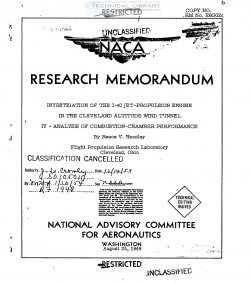naca-rm-e8g02c
- Version
- 30 Downloads
- 1.35 MB File Size
- 1 File Count
- April 21, 2017 Create Date
- April 21, 2017 Last Updated
National Advisory Committee for Aeronautics, Research Memorandum - Investigation of the I-40 Jet Propulsion Engine in the Cleveland Altitude Wind Tunnel - IV - Analysis of Combustion Chamber Performance

Combustion-chamber performance characteristics of the 1-40
Jet-propulsion engine were determined from an investigation of the
complete engine installed in an airplane fuselage in the Cleveland
altitude wind tunnel over a range of ram pressure ratios from 0.98
to 1.76. The standard type C combustion chamber and a modified
type E combustion chamber were investigated.
The combustion-chamber performance characteristics are pre-
sented as functions of the engine speed corrected to NASA standard
sea-level inlet conditions. The effect of variations in altitude
and ram pressure ratio on combustion efficiency and on combustion-
chember pressure losses is presented. The decrease in engine-
cycle efficiency due to combustion—chamber pressure losses is
evaluated.
Combustion efficiency varied directly with the ram pressure
ratio and engine speed and inversely with the altitude. The combus-
tion efficiency was generally higher for the type C combustion
chamber than for type E. Pressure losses of about 6 percent of the
combustion-chamber-inlet total pressure were obtained with the
type C combustion chamber and slightly lower losses were encountered
with the type B combustion chamber. Percentage losses in total
pressure were inappreciably affected by changes in altitude or ram
pressure ratio up to a value of l. 3. At rated engine speed, the
decrease in engine-cycle efficiency due to combustion-chamber
pressure losses was slight; the fractional loss varied inversely as
the engine speed, generally reaching a value of one -half the engine-
cycle efficiency attained at a corrected engine speed between 6000
and 8000 rpm.
An investigation under simulated flight conditions of the per-
formance of the 1-40 engine installed in an airplane fuselage has
been conducted in the Cleveland altitude wind. tunnel. lI'he perform-
ance and operational characteristics of the component parts of the
12-40 Jet-propulsion engine installed in this airplane were deter-
mined in addition to the evaluation of the over-all characteristics.
Reference 1 summarizes the over-all engine -performance and wind-
milling drag characteristics of the unit and references 2 and 3
present the performance characteristics of the compressor and the
turbine, respectively, as determined from the investigation of the
complete engine.
| File | Action |
|---|---|
| naca-rm-e8g02c Investigation of the I-40 Jet Propulsion Engine in the Cleveland Altitude Wind Tunnel - IV - Analysis of Combustion Chamber Performance.pdf | Download |

Comment On This Post